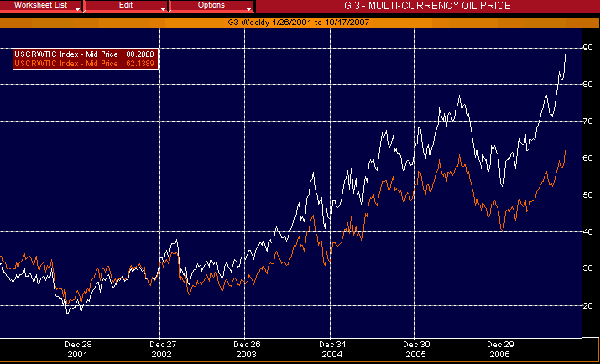Oil hit a new high today, $89 a barrel. Some analysts predict it will soon hit $100. All this has caused much anxiety in the markets and handwringing in the press, which has generally attributed the increase to 1) unrest in the Middle East 2) increased demand, particularly from China and India and 3) speculators.
Okay, so all of these things are a factor to some extent. But what analysts and pundits generally fail to point out is another reason for high oil prices in the U.S. market is the devaluation of the dollar. If it weren’t for that, oil would cost about $60 a barrel, as it does effectively does in Europe and Canada. On George W. Bush’s inauguration day in January 2001, you could have purchased a barrel of oil for about $30. If you lived in Europe, a barrel would have set you back about 32 Euro. Because the value of the U.S. Dollar has fallen so substantially since then (it took 93 cents to buy a Euro in January 2001, it now takes $1.42), the increase in the cost of oil for a U.S. consumer has far outstripped the increase for a Euro (or Canadian, or Swiss, or just about any other) consumer.
Today, it takes US $89 to buy a barrel of oil, but only 62 Euro. Going from 32 Euro to 62 is a healthy rise, but is less than a 10% annual increase since Bush has been in office. By contrast, the move from $30 to $89 is nearly a tripling, or more than 17% per year. See this chart, where the price of oil in U.S. dollars is represented in white while the price in Euros is in red:

Thus, of the $59 increase in the cost of a barrel of oil to a U.S. consumer, more than $30 is due to the depreciation of the U.S. Dollar and the fiscal and trade policies that have contributed to it. Not Middle East tensions, not China’s increased appetite, etc. Same thing is true with skyrocketing price of gold; gold is going through the roof, sure, but what’s really happening is that the dollar is going through the floor.
Many things have led to the devaluation of the U.S. Dollar. But a big portion of it can be attributed to a growing deficit. Now some, like MoJo contributor James K. Galbraith, would argue that deficits per se aren’t bad. But the problem with this deficit is that it is largely attributable to 1) runaway spending on a disastrous war with no end in sight—in fact the chart shows how the divergence between currencies really starts to pick up following the invasion—and 2) massive tax cuts to the wealthy.
And that ain’t good.










